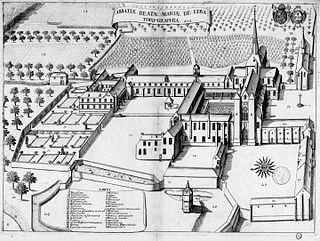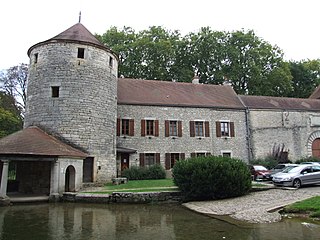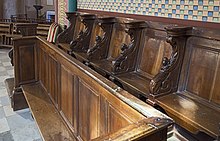
Clairvaux Abbey was a Cistercian monastery in Ville-sous-la-Ferté, 15 kilometres (9.3 mi) from Bar-sur-Aube. The abbey was founded in 1115 by Bernard of Clairvaux. As a primary abbey, it was one of the most significant monasteries in the order. Dissolved during the French Revolution, it was used from 1808 to 2023 as Clairvaux Prison, a high-security correctional facility. As of 2024, work is in process to make the space available and attractive to tourists.

Cîteaux Abbey is a Catholic abbey located in Saint-Nicolas-lès-Cîteaux, south of Dijon, France. It is notable for being the original house of the Order of Cistercians. Today, it belongs to the Trappists.

Lérins Abbey is a Cistercian monastery on the island of Saint-Honorat, one of the Lérins Islands, on the French Riviera, with an active monastic community.

Thoronet Abbey is a former Cistercian abbey built in the late twelfth and early thirteenth century, now restored as a museum. It is sited between the towns of Draguignan and Brignoles in the Var Department of Provence, in southeast France. It is one of the three Cistercian abbeys in Provence, along with the Sénanque Abbey and Silvacane, that together are known as "the Three Sisters of Provence."

Micy Abbey or the Abbey of Saint-Mesmin, Micy, sometimes referred to as Micy, was a Benedictine abbey near Orléans at the confluence of the Loire and the Loiret, located on the territory of the present commune of Saint-Pryvé-Saint-Mesmin. Since 1939 it has hosted a community of Carmelites.
William VII of Montpellier, the eldest son of William VI and of his wife Sibylle, was as 12th century Lord of Montpellier.
Tamié Abbey is a Cistercian monastery, located in the Bauges mountain range in the Savoie region of France.
Gerald of Sales was a French monastic reformer from Salles, Lot-et-Garonne near Bergerac, Dordogne in the south-west of France. His feast day is on April 20.

Vaux-de-Cernay Abbey is a former Cistercian monastery in northern France (Île-de-France), situated in Cernay-la-Ville, in the Diocese of Versailles, Yvelines. The abbey was abandoned during the French Revolution and fell into partial ruin. Most of the buildings, except for the church, were restored in the late 19th century by Charlotte de Rothschild, and the property is now a hotel.

The Feuillants were a Catholic congregation originating in the 1570s as a reform group within the Cistercians in its namesake Les Feuillants Abbey in France, which declared itself an independent order.

Barbeau Abbey is a former Cistercian monastery in Fontaine-le-Port in the French department of Seine-et-Marne. It was located approximately 10 kilometers northeast of Fontainebleau and 8 kilometers southeast of Melun.

Valmagne Abbey is a former Benedictine monastery located near Villeveyrac, Hérault, in south-central France. It is a designated historic monument.

The Abbey of St. Mary of Lagrasse is a Romanesque abbey in Lagrasse, southern France, whose origins date to the 7th century. It is located in Languedoc, near the Corbières Massif, about 35 km from Carcassonne. It was originally a Benedictine monastery, but since 2004 has been home to a community of canons regular.

Moissac Abbey was a Benedictine and Cluniac monastery in Moissac, Tarn-et-Garonne in south-western France. A number of its medieval buildings survive, including the abbey church, which has a famous and important Romanesque sculpture around the entrance.

Igny Abbey or Val d'Igny Abbey is a Cistercian abbey located in Arcis-le-Ponsart, Marne, France. It was founded in 1128 for Cistercian monks, dissolved in 1791 during the French Revolution, re-established in 1876 for Trappist monks, destroyed in 1918, reopened in 1929 for Trappist nuns and modernised in 2008–12 to accommodate three or four pre-existing communities.

Lyre Abbey was a monastery in Normandy, founded in 1046 at what is now the village of La Vieille-Lyre. From the mid-12th century it was a Benedictine house. It was abolished at the French Revolution and the abbey buildings mostly destroyed.

The Bèze Abbey, was a monastery founded in 629 AD in Burgundy, France. It was destroyed several times during the next three centuries by Frankish warlords, Saracens, Normans and Hungarians. At the end of the 10th century the abbey was re-founded and entered a golden age for the next two centuries. By the 13th century the spiritual life of the abbey had declined and the monks were mainly concerned with temporal matters. The abbey lost most of its monks during the Hundred Years' War and the Black Death of the 14th century. In 1429 it was fortified with stone walls, a moat and towers, two of which have survived. The abbey was again devastated by feuds in 1513, by the French Wars of Religion (1562–98) and by the Thirty Years' War (1618–48).

Cadouin Abbey was a Cistercian monastery founded as a hermitage in 1115 by Gerald of Salles, in the name of Robert of Arbrissel, in what is now the commune of Le Buisson-de-Cadouin in the Dordogne, south-west France.
Ardorel Abbey, formally the Abbey of Our Lady of Ardorel, was a Benedictine then Cistercian monastery located in the modern-day commune of Payrin-Augmontel, Tarn, southwestern France. It was destroyed during the Wars of Religion.

Villeneuve Abbey, dedicated to Our Lady, was a Cistercian monastery at the present-day Les Sorinières, near Nantes in Pays de la Loire, France, founded in 1201 and dissolved in 1790, during the French Revolution.

















